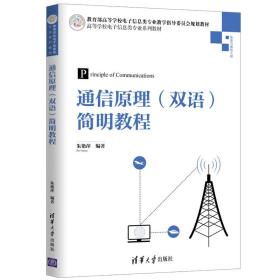
通信原理(双语)简明教程/朱艳萍
全新正版 极速发货
¥ 30.04 6.1折 ¥ 49 全新
仅1件
广东广州
认证卖家担保交易快速发货售后保障
作者朱艳萍
出版社清华大学出版社
ISBN9787302520573
出版时间2019-06
装帧平装
开本16开
定价49元
货号1201900581
上书时间2024-08-05
- 最新上架
商品详情
- 品相描述:全新
- 商品描述
-
目录
Chapter 1 Introduction
1.1 Basic concepts and models of communication system
1.1.1 Communication system model
1.1.2 Analog communication model
1.1.3 Digital communication model
1.2 The classification of communication systems
1.2.1 Modulation mode
1.2.2 Division of frequency band
1.3 Information and its measurement
1.4 The main performance index of communication systems
Summary and discussion
Homework
Vocabulary
Chapter 2 Random processes
2.1 Basic concepts of random processes (Definition of random processes)
2.1.1 Definition
2.1.2 Numerical characteristics of a random process
2.2 Stationary Random Process
2.2.1 Definitior
2.2.2 Ergodicity
2.2.3 Autocorrelation function of stationary random processes
2.2.4 Power Spectral Density
2.3 Gaussian process
2.4 Transmission of a random process through a Linear Time-Invariant (LTI) filter
2.5 Narrowband random process
2.6 Sine wave plus narrowband Gaussian noise
2.7 Gaussian white noise and band pass white noise
Summary and discussion
Homework
Vocabulary
Chapter 3 Channel
3.1 The classification of channels
3.1.1 Wireless channels
3.1.2 Wire channel
3.2 Channel models
3.2.1 Modulation channel model(调制解调模型)
3.2.2 Coding channel model(编码信道模型)
8.3 Influence of the channel characteristies on transmission (for modulation model)
3:3.1 Influence of constant parameter channel on signal transmissior
3.3.2 Influence of random parameter channel of signal transmissior
3.4 Channel capacity (continuous channel)
Summary and discussion
Homework
Vocabulary and terminologies
Chapter 4 Continuous-wave modulation (Analog modulation system)
4.1 Introduction
4.2 Linear modulation
4.2.1 AM
4.2.2 Double-Sideband Modulation
4.2.3 Single-Sideband Modulation
4.2.4 Vestigial Sideband Modulation
4.3 Anti-noise performance of linear demodulation
4.3.1 Noise in linear receiver using coherent detection
4.3.2 Noise in AM receivers using envelope detection
Homework(part1)
4.4 Angle modulation (Non-linear modulation process)
4.4.1 Basic definitions
4.4.2 NBFM(窄带调频)
4.4.3 Wide-band frequency modulation (WBFM)
4.4.4 Generating an FM signal
4.4.5 Demodulation of FM signals
4.4.6 Noise in FM receivers
4.5 Frequency-division multiplexing(频分复用)
Summary and discussion
Homework(part 2)
Terminologies
Chapter 5 Pulse modulation
5.1 Sampling process
5.2 Analog pulse modulation(模拟脉冲调制)
5.3 Quantization process(量化过程)of sampled signal
5.3.1 Uniform quantization(均匀量化)
5.3.2 Nonuniform quantization
5.4 PCM(Pulse code modulation,脉冲编码调制)
5.4.1 The principle of PCM
5.4.2 Noise in PCM system
5.4.3 Delta modulation(增量调制)
我的手机 2019-06-25 10:02:24
5.4.4 DPCM(Differential pulse code modulation,差分脉冲调制)
5.5 TDM(Time-Division Multiplexing,时分复用)
Summary and discussion
Homework
Terminologies
Chapter 6 Baseband pulse transmission
6.1 Waveform and frequency characteristics of baseband digital signal
6.1.1 Waveform of baseband digital signal
6.1.2 Symbol code types of baseband digital signals for transmission
6.1.3 Frequency characteristic
6.2 Matched filter
6.3 Error rate due to noise
6.3.1 Binary polar baseband system
6.3.2 The unipolar baseband system
6.4 Intersymbol Interference
6.4.1 Nyquists criterion I
6.4.2 Nyquists criterion Ⅱ
6.5 Eye pattern
Summary and discussion
Homeworlk
Terminologies
Chapter 7 Passband data transmission (Digital passband transmission)
7.i The basic principle of three digital passband modulation
7.1.1 ASK
7.1.2 FSK
7.1.3 PSK(Absolute phase shift keying)
7.1.4 DPSK(Differential PSK)
7.2 Anti-noise performance of digital passband modulation system
7.2.1 Bit error rate of ASK
7.2.2 Bit error rate of 2FSK
7.2.3 Bit error rate of PSK
7.2.4 Performance comparison of digital keying transmission systen
7.3 Hybrid amplitude/phase modulation schemes
7.4 OFDM system
Summary and discussion
Homework
Terminologies
Chapter 8 Further reading:new technologies in communication systems
8.1 Compressive sensing(CS)
8.1.1 Introduction
8.1.2 The mathematics theory
8.1.3 Application
8.2 Ultra wideband (UWB)system
8.2.1 The definition of UWB
8.2.2 Comparison with other wireless communications
8.2.3 Feature of UWB
8.2.4 Impulse modulation signal in UWB signal
8.2.5 The application of UWB
8.3 MIMO technology
8.3.1 The model of MIMO
8.3.2 Applications
References of Chapter 8
附录A MATLAB仿真实验
Experiment 1 Continuous-wave modulation (Corresponding to Chapter 4)
Experiment 2 Pulse modulation (Corresponding to Chapter 5)
Experiment 3 Digital passband transmission(Corresponding to Chapter 7)
附录B 实验箱实验
实验一 各种模拟信号源实验
实验二 脉冲编码调制PCM
实验三 AMI/HDB、编码和译码过程实验
实验四 FSK调制解调实验
实验五 通信系统综合实验
附录C 误差函数表
参考文献
内容摘要
本书重点介绍通信系统中各种通信信号的产生、传输和调制解调的基本理论和方法,使学生熟悉并掌握通信系统的基本理论和分析方法,为后续课程打下良好的基础。
在通信系统数学模型和相关数学工具的基础上,本书着重介绍模拟调制系统、数字基带/频带系统、模拟信号的数字传输系统等内容,涉及经典的调制解调、编码译码方法,并注重从系统的角度进行分析和理解。全书共分为8章,各章之间既独立又相互联系; 为了把知识点和相互联系清晰地表示出来,章首一般都有思维导图。在学习过程中应注重学习方法和技巧的总结,从系统和全局的角度对教材进行整体把握。
本书适合电子信息、通信工程和计算机等相关专业本科生的高年级学生学习使用。
相关推荐
— 没有更多了 —




















以下为对购买帮助不大的评价